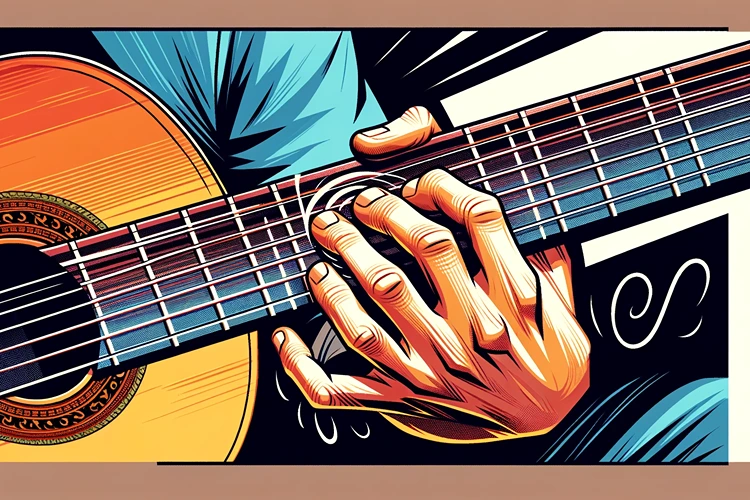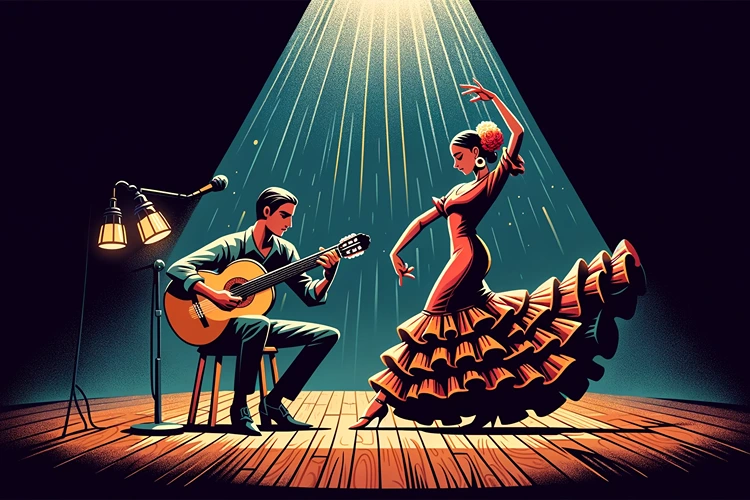Have you ever felt the fiery passion of Flamenco music and wished you could express it through your fingers? Flamenco guitar, with its rich history and complex techniques, offers a unique challenge to beginners eager to dive into its vibrant world. Yet, as exhilarating as the journey is, mastering Flamenco guitar techniques comes with its set of hurdles. Let’s explore these challenges and how to overcome them, ensuring your Flamenco guitar journey is as rewarding as the music itself.
Understanding Flamenco’s Unique Rhythms
Getting the hang of Flamenco’s rhythms, or “compás,” is crucial yet challenging for newcomers. This rhythm isn’t just a beat; it’s the soul of Flamenco, setting the stage for its dramatic and emotive flair. Let’s break down what makes compás so essential and how to get comfortable with it.
What is Compás?
Compás is more than a time signature in Flamenco music; it’s a complex system of rhythmic cycles that dictates the flow and mood of the music. Each Flamenco style, or “palo,” has its own compás, making it vital to understand and master these patterns to truly express the essence of Flamenco.
Common Rhythmic Patterns
- Bulerías: Fast and lively, this 12-beat cycle is a true test of your rhythmic skills.
- Soleá: The soulful heart of Flamenco, Soleá’s compás is slower, allowing for expressive play within its 12-beat pattern.
- Tangos: Not to be confused with the Argentine dance, Flamenco Tangos offer a 4-beat rhythm that’s perfect for beginners.
Mastering Rhythms with a Metronome
Using a metronome is non-negotiable when learning Flamenco. It’s not just about keeping time; it’s about internalizing the pulse of Flamenco, allowing you to weave through its complex rhythms with precision and feeling.
Helpful Hint:
Combine metronome practice with clapping (palmas) to Flamenco rhythms. This hands-on approach helps you feel the compás physically, deepening your rhythmic understanding.
Why Listening to Flamenco Music Matters
Immersing yourself in Flamenco music is key to mastering its rhythms. Listening attentively to professional performances reveals the nuanced ways artists play within and around the compás, offering invaluable lessons on rhythm and timing.
- Focus on how the guitarist complements the dancer’s footwork with their rhythm.
- Notice the interaction between the singer’s phrasing and the guitar’s compás.
- Practice identifying the different palos by their rhythmic patterns.
Embarking on the Flamenco guitar path introduces you to a world where each strum and pluck carries the weight of a rich cultural heritage. Flamenco techniques, with their depth and complexity, serve as the building blocks for this expressive art form. Let’s dive deeper into these techniques, exploring how to bring the vibrant spirit of Flamenco to life through your guitar playing.
Exploring Rasgueado

Rasgueado, with its explosive energy, is essential for any Flamenco guitarist. This technique involves fanning out the fingers in a rapid, percussive strum, adding a dramatic flair to the music. Achieving a fluid rasgueado takes time, but it’s key to capturing Flamenco’s essence.
- Start with the basics: Practice with one finger before adding more to the sequence.
- Focus on wrist flexibility: A loose wrist allows for a smoother, more natural rasgueado.
- Rhythm is king: Pair rasgueado practice with a metronome to keep your strums sharp and in time.
Perfecting Picado
Picado demands precision, playing melodies with clear, articulated notes. This technique, where fingers alternately pluck the strings, showcases Flamenco’s melodic side. Mastery of picado adds a lyrical quality to your playing, weaving stories through melody.
- Consistent finger positioning: Ensure your fingertips strike the strings directly for a clean, crisp sound.
- Build up speed gradually: Start slow to focus on accuracy, then increase speed as your confidence grows.
- Integrate scales: Practicing scales with picado technique improves dexterity and note clarity.
Stats:
Practicing these Flamenco techniques for even 15 minutes a day can lead to noticeable improvements within weeks. The key is consistent, focused practice.
Unlocking the Mystique of Flamenco Modes
Flamenco’s allure is partly due to its unique musical modes, which evoke an array of emotions and atmospheres. Among these, the Phrygian mode stands out, painting Flamenco’s soundscape with its dark, passionate hues. Let’s uncover the magic behind these modes and how they define Flamenco’s soulful melodies.
The Heart of Flamenco: Phrygian Mode
The Phrygian mode, dominant in Flamenco music, is renowned for its exotic, Spanish vibe. This mode is characterized by its minor second interval, giving Flamenco that quintessential, emotional edge. Understanding how to navigate and incorporate the Phrygian mode into your playing is fundamental for any Flamenco guitarist.
- Listen and learn: Immerse yourself in Flamenco pieces that utilize the Phrygian mode to get a feel for its sound and mood.
- Practice makes perfect: Use the Phrygian mode in your improvisations and compositions to become comfortable with its intervals and characteristics.
- Mode mixing: Experiment with blending the Phrygian mode with other scales and modes to create unique soundscapes.
Harmonic Minor Scale
Another key element in Flamenco music, the harmonic minor scale, introduces tension and resolution, adding emotional depth to the performance.
Overcoming Technical Challenges
Besides the unique techniques and rhythms, beginners often face physical challenges, such as developing finger strength and dexterity. Regular practice, focused exercises, and proper hand positioning can help overcome these obstacles.
Developing the Right Hand Technique
Flamenco guitar demands intricate right-hand techniques, not only for rhythm but also for tone and volume control. The challenge lies in coordinating these movements to produce the music’s characteristic emotional intensity.
Alzapúa
A technique unique to Flamenco, alzapúa involves thumb strokes that alternate between melody and accompanying bass lines, creating a full, rich sound. Mastering alzapúa requires patience and practice to ensure clarity and precision.
Golpe
Golpe is the technique of tapping the guitar body with the fingers or palm to add percussive elements to the music. Learning the correct timing and force for golpes can be challenging but is essential for authentic Flamenco performance.
Helpful Hint:
For right-hand techniques, focus on one at a time. Isolate the movements, practicing slowly and deliberately, before speeding up. This builds muscle memory and ensures accuracy.
Memorizing Flamenco Song Structures
Flamenco compositions can be complex, with distinct sections and changes in rhythm. Beginners might find memorizing these structures daunting, affecting their ability to play songs from start to finish.
Falsetas
Falsetas are melodic phrases in Flamenco music, often complex and requiring precise execution. Learning and memorizing falsetas is vital for any Flamenco guitarist.
Cante Accompaniment
Accompanying singers (cante) in Flamenco adds another layer of complexity, as it requires understanding the song’s structure and dynamics to support the vocals effectively.
Stats:
Engaging in active listening and analysis of Flamenco performances can improve a beginner’s ability to understand and memorize song structures, with a noticeable improvement seen in students who dedicate time to listening practice.
Building Endurance and Finger Strength
The vigorous nature of Flamenco guitar playing puts a demand on both endurance and finger strength. This can be particularly challenging for beginners, who may struggle with longer practice sessions or faster passages.
Effective Practice Routines
Structured practice routines, focusing on gradually increasing difficulty and duration, can help build the necessary endurance and finger strength for Flamenco guitar.
Stretching and Warm-up Exercises
Incorporating stretching and warm-up exercises before playing helps prevent strain and improves overall dexterity and flexibility.
FAQs
Bottom Line
Embarking on the Flamenco guitar journey is both challenging and immensely rewarding. By understanding and addressing the common hurdles beginners face, you can set a solid foundation for your Flamenco skills. Remember, perseverance, patience, and practice are key to mastering the art of Flamenco guitar. Embrace the challenges, and let your passion for Flamenco music drive you towards achieving mastery.
Additional Resources
- Flamenco Export: Offers a wide range of Flamenco music resources, including tutorials and accessories for enthusiasts.
- Andalucía Flamenco: An official site providing information about Flamenco’s cultural heritage in its birthplace, with event listings and artist profiles.
- Paco de Lucía: Dedicated to the legendary Flamenco guitarist, this site offers insights into his techniques and contributions to Flamenco music.
- Flamenco Guitar Secrets: Provides online lessons focused on Flamenco guitar techniques for various skill levels.

